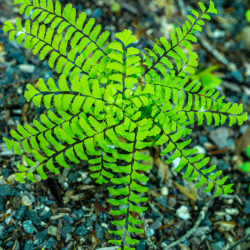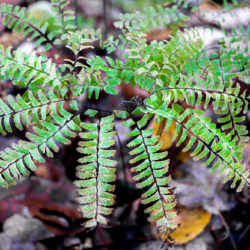Etymology
Adiantum is Greek (adiontos) for unwetted, in that the foliage is water-repellent, and pedatum is Latin for the bird-foot shaped appearance of the fronds.
Garden Uses
Attractive ornamental fern for shaded, moist borders. Naturalizes well with low maintenance.
Overview
Clumping fern, with overall height 1 to 2-1/2 ft, and individual clumps spreading 1 to 1-1/2 feet, growing in part to heavy shade. Prefers humusy, acidic, moist but well-drained soil. Spreads slowly by branching rhizomes to form large colonies over time. The common name refers to the thin, wiry, dark stems.
Leaves and Stems
Deciduous, with finely-textured somewhat frilly and fan-shaped fronds on curved stalks, with stems that tend toward wiry, hairy, and reddish-brown to black. Fronds are palmately-divided (finger-like projections). Leaf blades are three-times compound (divided into leaflets, which are further divided into leaflets, which are further divided one or more times), and approximately 1 ft long. Fiddleheads, or crosiers, are pink as they emerge in spring.
Fruit/Seed
Spore-bearing and non-spore-bearing fronds are similar in size.
Wildlife Associates
Considered deer-resistant.
Ethnobotanical Uses
Native Americans have used this fern medicinally, and the frond stems in basketry and to maintain patency of body piercings.
Garden Location
Performance Hall Garden (see garden map)
Sources
Plant Profile by Kate O’Dell



